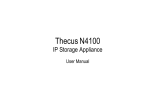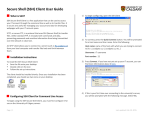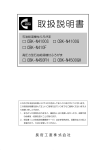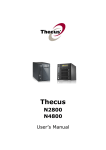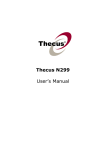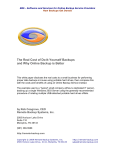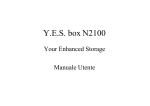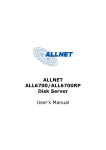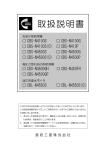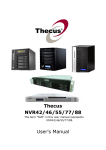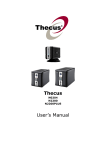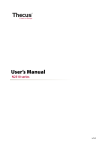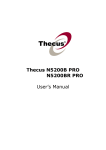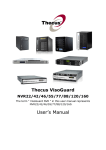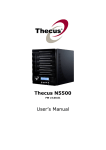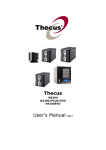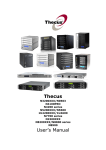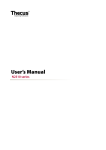Download English - Thecus
Transcript
Thecus N4100 IP Storage Appliance User’s Manual Thecus N4100 IP Storage Appliance Copyright and Trademarks Copyright © 2005 Thecus Technology Corporation. Specifications are subject to change without notice. All rights reserved. Thecus is a registered trademark of Thecus Technology Corp. Microsoft, Windows, and the Windows logo are registered trademarks of Microsoft Corporation. Apple and Apple OS X are registered trademarks of Apple Computer, Inc. All other trademarks and brand names are the property of their respective owners. About This Manual All information in this manual has been verified carefully to ensure the correctness of its contents. In case of error, please provide us with your feedback. Thecus Technology Corp. reserves the right to modify the contents of this manual without notice. Limited Warranty Thecus Technology Corp. guarantees all products are thoroughly tested before they leave the factory and should function normally under general conditions. In case of any system malfunction, Thecus Technology Corp. and its local representatives and dealers are responsible for repair without cost to the customer if the product fails within the warranty period and under normal usage. Thecus Technology Corp. is not responsible for any damage or loss of data deemed to be caused by its products. It is highly recommended that users conduct necessary back-up practices. Product name: Thecus N4100 Manual Version: 1.1 Release Date: October 2005 i Thecus N4100 IP Storage Appliance Table of ContentsCopyright and Trademarks ........................................................ i About This Manual .................................................................................................... i Limited Warranty....................................................................................................... i Chapter 1: Introduction ........................................................................................... 1 Benefits .................................................................................................................. 1 Key Features .......................................................................................................... 1 Unpacking .............................................................................................................. 2 Chapter 2: Hardware Overview ............................................................................... 3 The Front Panel...................................................................................................... 3 Hard Disk Tray ....................................................................................................... 4 The Back Panel ...................................................................................................... 4 Chapter 3: Installing & Connecting ........................................................................ 5 Installing Hard Drives ............................................................................................. 5 Making Connections ............................................................................................... 6 Checking System Status ........................................................................................ 6 Checking System Status ........................................................................................ 7 System Status OK............................................................................................... 7 System Trouble................................................................................................... 7 Chapter 4: First Time Setup .................................................................................... 8 Overview ................................................................................................................ 8 Installation Wizard .................................................................................................. 8 Chapter 5: System Management ( for Administrator ) ........................................ 12 Login..................................................................................................................... 12 Status Menu ......................................................................................................... 13 System Status Screen ...................................................................................... 13 System Information Screen............................................................................... 14 Product Information Screen .............................................................................. 14 Storage Menu....................................................................................................... 15 Disks Information Screen.................................................................................. 15 RAID Information Screen .................................................................................. 16 RAID Configuration Screen............................................................................... 16 Folder Screen ................................................................................................... 18 Access Control Setup ....................................................................................... 20 Nsync screen .................................................................................................... 22 How to Add a Nsync Task................................................................................ 23 How to set up Nsync Target on N4100 ............................................................. 24 ii Thecus N4100 IP Storage Appliance How to set up Nsync Target on Other Device................................................... 24 How to set up secure transfer between two N4100s......................................... 25 Network Menu................................................................................................... 26 Network Configuration Screen .......................................................................... 26 Service Screen ................................................................................................. 27 FTP Screen....................................................................................................... 27 Accounts Menu..................................................................................................... 28 ADS/NT Support Screen................................................................................... 28 Users Screen .................................................................................................... 29 Groups Screen.................................................................................................. 30 System Menu ....................................................................................................... 31 Notification Configuration Screen ..................................................................... 31 System Logs Screen......................................................................................... 32 System Logs Screen......................................................................................... 32 Time Screen ..................................................................................................... 32 Configuration Management Screen .................................................................. 33 Factory Default Screen ..................................................................................... 33 Firmware Upgrade Screen................................................................................ 34 Administrator Password Screen........................................................................ 34 Reboot & Shutdown Screen.............................................................................. 35 Logout Screen .................................................................................................. 35 Language Menu ................................................................................................... 36 Thecus IP Storage Monitor................................................................................... 37 Chapter 6: System Usage ( for users ) ................................................................. 40 Mapping a Network Drive (Windows) ................................................................... 40 Mapping a Network Drive (Apple OS X) ............................................................... 42 Network Addresses........................................................................................... 42 Connecting to a Server ..................................................................................... 42 Using WebDisk ..................................................................................................... 44 Windows XP Data Backup.................................................................................... 46 Installing the Windows XP Home Edition Backup Utility ................................... 46 Using the Backup Utility .................................................................................... 46 Mac OS X Backup Utilities.................................................................................... 47 Forgotten Network IP Address or Password......................................................... 48 Error Detection ..................................................................................................... 49 Solving Problems ................................................................................................. 49 iii Thecus N4100 IP Storage Appliance Hard Drive Replacement ...................................................................................... 50 Hard Drive Damage .......................................................................................... 50 Replacing a Hard Drive..................................................................................... 50 RAID 5 Auto-Rebuild......................................................................................... 51 Appendix B: Setting IP Addresses ....................................................................... 52 Windows XP ......................................................................................................... 52 Mac OS X ............................................................................................................. 54 Appendix C: RAID Basics...................................................................................... 55 RAID Introduction ................................................................................................. 55 Benefits............................................................................................................. 55 Improved Performance ..................................................................................... 55 Data Security .................................................................................................... 55 RAID Overview..................................................................................................... 56 Stripe Size ........................................................................................................ 56 Choosing a RAID Level ........................................................................................ 57 RAID 0.................................................................................................................. 58 RAID 1.................................................................................................................. 59 RAID 5.................................................................................................................. 60 Appendix D: Active Directory ............................................................................... 61 What is Active Directory? ..................................................................................... 61 ADS Benefits ........................................................................................................ 61 Appendix E: Specifications................................................................................... 62 iv Thecus N4100 IP Storage Appliance Chapter 1: Introduction Thank you for choosing the Thecus N4100 IP Storage Appliance. The Thecus N4100 is an easy-touse storage appliance that allows a dedicated approach to storing and distributing data on a network. Data reliability is ensured with RAID features that provide data security and recovery—over one Terabyte of storage is available using RAID 5. Two Gigabit Ethernet ports enhances network efficiency, allowing the N4100 to take over file management functions, increase application and data sharing and provide faster data response. The N4100 offers data mobility with a disk roaming feature that lets you hot swap working hard drives for use in another N4100, securing the continuity of data in the event of hardware failure. The N4100 allows data consolidation and sharing between Windows (SMB/CIFS), UNIX/Linux, and Apple OS X environments. The N4100’s user-friendly GUI supports multiple languages. Benefits Key Features Data Reliability • Easy-to-use for non-MIS personnel • RAID Level 1, 5 • 4 SATA (Serial ATA) interfaces • RAID Auto Rebuild • Over 1 tera byte storage on a RAID 5 (also supports • Disk Backup • Hot Spare Data Mobility RAID 0, 1 and JBOD) • Networked Storage on Gigabit Ethernet • Data can be replicated by Disk Roaming • Disk Roaming • Supports Hot Swap • Hot Swap • Multiple languages and easy to use GUI Data Access Acceleration • Affordable for SOHO and Power Users • Gigabit Ethernet Data Sharing & Consolidation • Windows (SMB/CIFS) • UNIX/Linux • Apple OS X Data Capacity • Over 2 tera byte capacity • RAID Level 0, JBOD 1 Thecus N4100 IP Storage Appliance Unpacking Before unpacking the Thecus N4100 check that the package is not damaged. Items in the package include: • Thecus N4100 IP Storage Appliance • Power cord • RJ45 cable • Accessory bag containing keys, disk tray screws, and front panel screw. • CD with user manual and related documents • Quick Installation Guide (QIG) If you have any questions, please contact your local dealer. 2 Thecus N4100 IP Storage Appliance Chapter 2: Hardware Overview The front and back panels of the Thecus N4100 feature the device’s hardware interface and connections. The Front Panel The Thecus N4100’s front panel has the device’s controls, indicators, and hard disk trays. HDD Trays There are four hard disk drive (HDD) trays. Each tray supports a 3.5-inch SATA HDD. The trays have locks for added physical security and keys are provided with the package. Indicators The indicators show when various operations take place. Power LED This LED glows blue when the device is powered on. Busy LED This LED blinks orange when the system is booting up, or during maintenance and is unable to provide access to data. LAN 1 LED This LED blinks green when there is network activity on the LAN 1 port. A steady green glow means there is a link but no activity. The LAN 1 port is always used for Gigabit Ethernet connection. LAN 2 LED This LED blinks green when there is network activity on the LAN 2 port. A steady green glow means there is a link but no activity. The LAN 2 port is used for either Gigabit Ethernet connection. Error LED When this LED glows a steady red, the system has detected an error. Power Switch Press the power switch briefly to power on the Thecus N4100. Press this switch again to power down. Reset Switch Press this switch to reset, if there is no response from the system. Note: The Reset switch can also reset Admin password and IP address to default settings—see Appendix A: Troubleshooting for instructions. 3 Thecus N4100 IP Storage Appliance Hard Disk Tray The Thecus N4100’s hard disk trays each have a lock, a latch, and two indicators. Lock The tray lock lets you physically secure the HDD with accessory keys. Latch Use the latch to open and remove or close and secure the tray. Indicators The indicators show when various operations take place. HDD Power LED This LED glows blue when the HDD is powered on. Access/Error LED This LED blinks green when the system is accessing data on the HDD. This LED also blinks red if a hard disk error occurs. The Back Panel The Thecus N4100’s back panel features ports and connectors. Power socket Connect the power cord to this universal socket LAN 1 The LAN 1 (Local Area Network) port connects to an Ethernet network through a switch or router. LAN 2 The optional LAN 2 (Local Area Network) port also connects to an Ethernet network through a switch or router. 4 Thecus N4100 IP Storage Appliance Chapter 3: Installing & Connecting This chapter describes installing and connecting hardware on the Thecus N4100. Installing Hard Drives The Thecus N4100 allows easy installation and changing of hard disk drives for convenient upgrade or repair. Install hard disk drives (HDD) into their trays as follows: 1. Remove an HDD tray from the Thecus N4100 IP Storage Appliance. (Photo 1) 2. Important! Check and make sure the HDD uses the SATA interface. (Photo 2) 3. Slide the new HDD into the tray and fasten the screws. (Photos 3 and 4) 4. Insert the HDD and tray back into the Thecus N4100 until it snaps into place and lock it with a key if desired. 5. The LED blinks green when the HDD is accessed. If the Error LED flashes red it signals a problem. Note: If your HDD was part of a RAID 1 or 5 array previously, it automatically rebuilds. If you replace all the drives with higher capacity drives, you need to go to Administrator login and format the drives. 5 Thecus N4100 IP Storage Appliance Making Connections Make the following connections on the Thecus N4100 and then power up. 1. Connect an Ethernet cable from your network to the LAN 1 port on the back panel of the Thecus N4100. (Step 1) 2. Connect the provided power cord into the universal power socket on the back panel. Plug the other end of the cord into a surge protector socket. (Step 2) 3. Press the power button on the front panel to power on the Thecus N4100.(Step 3) 6 Thecus N4100 IP Storage Appliance Checking System Status After making connections on the Thecus N4100 and powering up, check whether the system status is ok or has trouble by observing indicators on the front panel and HDD trays. System Status OK The system status is OK if: 1. The front panel Power LED glows blue and the LAN 1 LED glows or blinks green. 2. The HDD Power LED on each HDD tray glows blue. System Trouble The system has trouble if: 1. Any LED glows red. 2. The system emits a continuous beeping sound. If the system has trouble, refer to Appendix A: Troubleshooting. 7 Thecus N4100 IP Storage Appliance Chapter 4: First Time Setup Overview Once the hardware is installed, physically connected to your network, and powered on, you can now configure the Thecus N4100 so that it is accessible to your network users. Follow the steps below for initial software setup. Installation Wizard 1. Insert the installation CD into your CD-ROM drive (host PC must have connection to the above network). 2. The Setup Wizard should launch automatically. If not, please browse your CD-ROM drive and double click on Setup.exe 3. The Setup Wizard will start and automatically detect all Thecus IP storage devices on your network. If none are found, please check your connection and refer to the Troubleshooting Guide at the back of the N4100 User’s Manual. 4. Select the N4100 that you like to configure. 8 Thecus N4100 IP Storage Appliance 5. Login with the default administrator account and password. The default account and password are both “admin”. 6. Name your N4100 system and configure the network IP address. If you have a DHCP server on your network, you can configure the N4100 to automatically obtain an IP address from the DHCP server. You may also use a static IP address and enter the DNS Server address manually. 9 Thecus N4100 IP Storage Appliance 7. Enable the services you wish to make publicly accessible. The N4100 offers FTP Server. 8. Refer to the following chart and select the hard disk configuration that best suits your usage model. Setup Options Minimum Number of Disks Increased Reliability JBOD 1 No RAID 0 2 No RAID 1 2 Yes RAID 5 3 Yes JBOD – Files are stored in a linear fashion on any available hard disk drives. RAID 0 – Combine two or more physical hard disk drives into one logical drives. Data is separated into threads and stored across multiple physical drives. RAID 1 – Use the second hard disk drive as a mirror image of the first hard disk for increased reliability. RAID 5 – Data are stored across all the hard disk drives in small blocks. Parity for blocks is calculated for increased reliability.. 10 Thecus N4100 IP Storage Appliance 9. Change the default administrator password. 10. Finished! Access the current N4100 administrator webpage by pressing the “Start Browser” button. You can also configure another N4100 at this point. 11 Thecus N4100 IP Storage Appliance Chapter 5: System Management (for Administrator) When the system is setup and you are connected to a network, you can configure and manage the network through an internet browser such as Windows Internet Explorer. Login To access the Login webpage: 1. Type in the IP address in your browser’s address line. 2. The Login screen appears. 3. Type in your Username and Password. (You have to login here as a System Administrator) ( admin / admin ) 4. Press Login. 5. The About screen from the Status menu appears. Note 1: The default IP address is 192.168.1.100. Note 2: To access the IP address, your computer must be configured with the correct IP settings. See Appendix B for information. 12 Thecus N4100 IP Storage Appliance Status Menu The Status menu provides basic system information such as product model, hardware and software versions and profile of the system. A description of each menu item follows. System Status Screen From Status menu, choose System item, and the System Status and Disk Information screen appears. This screen provides basic system status information. The Disk Information screen can also be found in the Disks item in Storage menu. CPU loading Displays current CPU workload of N4100 Up time Shows how long the system has been running. Disk Slot Indicates disk location. Capacity Shows the disk capacity. Model Displays the hard disk model name. Firmware Shows the firmware version. Status Indicates the status of the hard disks, which may either be OK or Failed. Total capacity Shows the total disk capacity. 13 Thecus N4100 IP Storage Appliance System Information Screen From Status menu, choose Info item, and the System Information screen appears. You can change the system information that appears on the Login page by entering the new information here and pressing Apply to confirm. System description Shows a description of the system; it also appears on the Login page. Product Information Screen From the Status menu, choose the About item, and the Product Information screen appears. The Product Information screen provides the information about the system. Manufacturer Displays the name of the manufacturer of the system. Product No. Shows the model number of the system. Serial No. Displays the system’s serial number. Firmware version Shows the version of the firmware. Up time Displays the total running time of the system. 14 Thecus N4100 IP Storage Appliance Storage Menu The Storage menu provides disk information and allows you to configure RAID and sharing. Disks Information Screen From the Storage menu, choose the Disks item and the Disks Information screen appears. A disk information line would be blank if the disk slot is empty. If there is a problem with a disk the Status column will display “Failed”. Disk No. Indicates the disk location. Capacity Shows the disk capacity. Model Displays the hard disk model name. Firmware Shows the firmware version. Status Indicates the status of the disk, either OK or Failed. Total capacity Shows the total disk capacity 15 Thecus N4100 IP Storage Appliance RAID Information Screen From the Storage menu, choose the RAID item, and the RAID Information screen appears. The information displayed includes total memory capacity, RAID status, and the current RAID setting. To configure your RAID settings, press the Config button and the RAID Configuration screen appears. Raid level Shows the type of RAID setting for the system. Total Capacity Shows total capacity after the RAID configuration. Status Indicates status of the RAID, either Healthy or Failed. Used Percentage Displays percentage of used RAID capacity. Stripe Size Shows size of disk stripe. Remaining Time Indicates time remaining until the RAID is finished building. RAID Configuration Screen In the RAID Information screen, press “Config” to enter the RAID Configuration screen. In addition to RAID disk information and status, this screen lets you make RAID configuration settings. See Appendix C for basic information on RAID. RAID Level You can set the storage volume as either None, JBOD, RAID 0, RAID 1 or RAID 5. RAID configuration is usually required only when you first set up the device. A brief description of each RAID setting follows: None There is no existing storage volume. JBOD The storage volume is a single HDD with no RAID support. A minimum of 2 HDD is required. RAID 0 Provides data striping but no redundancy. Improves performance but not data safety. At least 2 HDD are required. RAID 1 Offers disk mirroring. Provides twice the read rate of single disks, but same write rate. Supports 2 HDD. RAID 5 Data striping and stripe error correction information provided. Excellent performance and good fault tolerance. 16 Thecus N4100 IP Storage Appliance Disk Settings With the Disk settings you can select stripe size and choose which disks are RAID disks or the Spare Disk as well as enter a name for each disk. Stripe size This sets the stripe size to maximize performance of sequential files in a storage volume. Keep the 64K setting unless you require a special file storage layout in the storage volume. A larger stripe size is better for large files. RAID Check the boxes of the HDDs you wish to add to the storage volume. Spare Disk Check a box to designate the replacement HDD for the storage volume. This becomes the backup for any damaged HDD. Add Spare Press this button to add a new Spare disk. Create RAID Press this button to configure a file system and create the RAID storage volume. Remove RAID Press this button to nullify the RAID storage volume. How to Create a RAID 1. In the RAID Configuration screen, Set the RAID storage space as JBOD, RAID 0, RAID 1 or RAID 5—see Appendix C for details. Note: If security is your primary concern, for 2 disks, choose RAID 1; for 4 disks, choose RAID 5. If capacity is your primary concern, choose JBOD or RAID 0. 2. Check the hard disks you wish to create a RAID on. Specify Stripe size—64K is a normal setting. 3. Press Create to build the RAID storage volume. Note: Building a RAID storage space may take time, depending on the size of hard drives and RAID mode. WARNING: Creating RAID destroys all data in the current RAID, and the data is unrecoverable. 17 Thecus N4100 IP Storage Appliance How to Add a Spare Disk You can add a spare disk after you already have a RAID set up. Note: You can only add a spare disk for RAID 5 level. 1. In the RAID Configuration screen add to the Spare check box of the disk you wish to add. 2. Press the Add spare button and the system automatically rebuilds. How to Remove a RAID 1. In the RAID Configuration screen click on the Remove RAID button. 2. The system automatically rebuilds and you can create a new RAID. WARNING: Removing RAID destroys all data in the current RAID, and the data is unrecoverable. Folder Screen From the Storage menu, choose the Folder item, and the Folder screen appears. This screen allows you to create and configure folders on the RAID storage volume. Folder name Displays the name of the Share folder. Edit Press this button to enter the Edit screen and modify the Folder’s name, description. Description Provides a description of the Folder. ACL Press ACL (Access Control List) to configure which users have access to this folder. Del Press this button to delete the folder. A screen appears asking to confirm deletion. Add Press this button and the Add Folder screen appears, from which you can add a new folder. 18 Thecus N4100 IP Storage Appliance Add Folder Screen In the Folder screen press Add button and the Add Folder screen appears. This screen allows you to add a folder. After entering the information, press Apply to add the new folder. Folder name Enter the name of the Folder. Comment Provide a description for the Folder. Browseable Choose Yes or No. Public Choose Yes or No. Edit Share Screen From the Folder screen, press the Edit button and the Edit Share screen appears. This screen allows you to change share/folder information. After entering the information, press Submit to change the settings. Share name Displays the name of the Share (Folder). Comment Change the description of the Share (Folder). Browseable Choose Yes or No. Public Choose Yes or No. 19 Thecus N4100 IP Storage Appliance ACL Screen In the Folder screen press the ACL button, and the Access Control List screen appears. This screen allows you to configure access to this Folder for the users and groups. Select a user or a group from the left hand column and then choose Deny, Read Only, or Writable to configure their access level. Press the Submit button to confirm settings. Deny Denies access to users or groups who are displayed in this column. Read Only Provides Read Only access to users or groups who are displayed in this column. Writable Provides Write access to users or groups who are displayed in this column. Remove Removes selected user or group from the column in order to re-set their access level Submit Submits and confirms settings. Reset Cancel your new setting. Access Control Setup You can control access to share folders using the Thecus N4100 browser-based software’s Access Control List (ACL). The ACL lets you determine which users and groups have access to which folders, as well as the level of their access. Set up the ACL as follows: 1. Login to the Thecus N4100 software. Select the Folder item from the Storage menu, and the Folder screen appears. 2. Choose a current Folder, or create a new Folder with the Add button, and press the ACL button. 3. The ACL screen appears. All network groups and users are listed in the left hand column. From this list select a group or user. 20 Thecus N4100 IP Storage Appliance 4. With the group or user selected, press one of the buttons from the three access level columns at the top. The group or user then appears in that column and has that level of access to the Folder. The three levels of access are: Deny Denies access to users or groups who are displayed in this column. Read Only Provides Read Only access to users or groups who are displayed in this column. Writable Provides Write access to users or groups who are displayed in this column. 5. Continue selecting groups and users and assigning them access levels using the column buttons. 6. To remove a group or user from an access level column, press the Remove button in that column. 7. When you are finished, press the Submit button to submit and confirm your ACL settings. Note: You must set the ACL for each folder for access by specific users and groups; otherwise the folder is inaccessible to all users and groups. 21 Thecus N4100 IP Storage Appliance Nsync screen You can backup a share folder to another N4100 (Target) or any FTP server for safe keeping as long as you have appropriate access right on that target. When using Nsync between two N4100, you have the option to transmit files securely between two N4100s. If the files on your N4100 are lost for any reason, you can restore those files from the target N4100. To backup files regularly, you can set up a scheduled task to run only once, daily, weekly, or monthly. You can also limit the bandwidth of your Nsync tasks, so other people can share the bandwidth equally. Nsync task name The name of your Nsync task Nsync Server The IP address of your target server Nsync Folder The share folder you want to backup. Last Time The time when the last Nsync task was executed. Last Status The status of your last Nsync task. Action Administrator can run or stop an Nsync task by pressing the Action button. Add Add a Nsync task Modify Modify an Nsync task. Delete Delete an Nsync task. When a task is deleted, backup files on Nsync target is also deleted. Restore Restore share folder from an Nsync target. Bandwidth Setting Bandwidth control on Nsync tasks. 22 Thecus N4100 IP Storage Appliance How to Add an Nsync Task From the Storage menu, choose the Nysnc item, and the NSync Information screen appears. Click on Add button, and Add Nsync Task screen appears. Manufacturer Select whether the target is a Thecus Product (eg. N4100) or FTP server. Target Server IP Address The IP address of your target server Nsync Folder The share folder you want to backup. Nsync Task Name The name of your Nsync task. AUTH ID The account ID on the target server. AUTH Password The password for the AUTH ID on the target server. Confirm Password Type in password second time for confirmation. Schedule Schedule backup of your share folders. Time The time when the Nsync task will run. Type Select whether to run the Nsync task daily, weekly, or monthly. When Weekly option is selected, administrator also has to decide what day of a week to execute the task. When Monthly option is selected, administrator also has to decide what day of a month to execute the task. Add Task To submit the task. 23 Thecus N4100 IP Storage Appliance How to set up Nsync Target on N4100 On the Nsync target server, the administrator of that server has to set up a user account with writable to nsync folder. 1. On the Nsync server, add a user for Nsync source (ex. nsyncsource1). For instructions on how to add a user on N4100, please go to section on “Add Users“ in Chapter 4. 2. On the Nsync server, add that user (ex. nsyncsource1) to writable list of nysnc folder. For instructions on how to set up ACL for a user, please go to section on “Setting the Access Control List (ACL) for a Folder” in Chapter 4. 3. Once this is done, the target server will start accepting Nsync task from server using that ID and password. How to set up Nsync Target on Other Device If you selected “Other Device” when setting up your Nsync task, N4100 will use FTP protocol to back up the share folder. Please make sure there is a folder named “nsync”, and the Auth ID has writable permission in that folder. 24 Thecus N4100 IP Storage Appliance How to set up secure transfer between two N4100s On the target N4100, from the Storage menu, choose the Target item, and the Secure Transfer Setting screen appears. Secure Transfer To enable or disable Secure Transfer. Segment When Secure Transfer is enabled, administrator has to select a IP segment that is not being used by any of Nsync source or target machine’s IP Network. Ex: Nsync source machine IP: 192.168.1.100 Nsync target machine IP : 192.168.2.100 Please select a Segment that is neither 192.168.1 nor 192.168.2. Apply To submit your changes. 25 Thecus N4100 IP Storage Appliance Network Menu Use the Network menu to make network configuration settings and as well as service support settings. Network Configuration Screen From the Network menu, choose LAN 1 or LAN2, and the Network Configuration screen appears. This screen displays the network parameters of the system. You are allowed to change any of these items and press Apply to confirm your settings. A description of each item follows: Host name Shows host name. Domain name Specifies the domain name. DHCP Select Enable for automatic IP settings or Disable to make your own IP settings. IP Specifies the IP address of the network connection Netmask Specifies the network mask, which is generally: 255.255.255.0 Gateway Specifies Gateway setting of your local area network DNS server Specifies the Domain Name Service (DNS) server. Note: Enabling DHCP automatically turns on UPnP—see the Service Support Screen. 26 Thecus N4100 IP Storage Appliance Service Screen From the Network menu, choose the Service item, and the Service Support screen appears. This screen displays the service support parameters of the system. You are allowed to change any of these items and press Apply to confirm your settings. A description of each item follows: WebDisk Support Enable or Disable WebDisk support. Set the port if Enabled. Secure WebDisk Support Enable or Disable secure WebDisk support. Set the port if Enabled. SMB/CIFS Enable or Disable SMB/CIFS protocol for Windows, Apple, Unix drive mapping. UPnP Enable or Disable Universal Plug and Play protocol. UPnP helps to find the IP address of the N4100. Note 1: Disable WebDisk (HTTP) support and Enable Secure WebDIsk (Secure HTTP) support to guarantee secure access. Note 2: In some environments, due to security concerns, you may wish to Disable SMB/CIFS as a precaution against computer viruses. FTP Screen From the Network menu, choose the FTP item, and the FTP server setting screen appears. The N4100 can act as a FTP server, enabling users to download and upload files with their favorite FTP client programs. FTP Enable or Disable FTP support. FTP ENCODE For user to select their file name encoding. Available options are BIG5, HZ, ISO, EUC-JP, and UTF-8 27 Thecus N4100 IP Storage Appliance Accounts Menu Use the Accounts menu to configure Active directory support, local users, and local groups. ADS/NT Support Screen From the Accounts menu, choose Authentication item and the ADS/NT Support screen appears. If you have a Windows Active Directory Server(ADS) or Windows NT server to handle the domain security in your network, you can simply enable the ADS/NT support feature; the N4100 will connect with the ADS/NT server and get all the information of the domain users and groups automatically. You are allowed to change any of these items and press Apply to confirm your settings. A description of each item follows: WINS Server Specifies the WINS server if necessary. Work Group / Domain Specifies the SMB/CIFS Work Group / ADS Domain Name (e.g. N4100). Name ADS/NT Support Select Disable to disable authentication through Windows Active Directory Server or Windows NT. Authentication Method Select ADS for Windows Active Directory Server, or select NT for Windows NT ADS/NT Server Name Specifies the ADS/NT server name (e.g. adservername). ADS/NT Realm Specifies the ADS/NT realm (e.g. example.com).. Administrator ID Enter the administrators ID of Windows Active Directory or Windows NT, which is required for N4100 to join domain. Administrator password Enter the ADS/NT Administrator password. Confirm Password: For re-entering password to confirm. 28 Thecus N4100 IP Storage Appliance Users Screen From the Accounts menu, choose Users item, and the Local User Configuration screen appears. This screen allows you to configure local user settings. If you change any of these items, press Apply to confirm your settings. A description of each item follows: Local User Configuration Lists All users Add Add a new user Modify Modify an existing user. Delete Delete an existing user. How to Add a User 1. Click on Add button in Local User Configuration, and Local User Setting screen appears. 2. In the Local User Setting screen, enter a name in the User Name box. 3. Enter a password in the Password box and re-enter the password in the Confirm box. 4. Select which group the user will belong to. Group Members is a list of groups this user belongs to. Group List is a list of groups this user does not belong to. Use the << or >> button to join or leave a group. 5. Press the Apply button and the User is created. How to Remove a User 1. Click on Delete button in Local User Configuration, and the user is deleted from the system. How to Change a User Password 1. In Local User Configuration screen, select an existing user, click on the Modify button, and Local User Setting screen appears 2. Enter a new password and re-enter to confirm and press Apply to confirm. 29 Thecus N4100 IP Storage Appliance Groups Screen From the Accounts menu, choose Groups item, and the Local Groups Configuration screen appears. This screen allows you to make local group settings. If you change any of these items, press Apply to confirm your settings. A description of each item follows: List of All Groups Lists all groups Add Add a new group. Modify Modify an existing group. Delete Delete an existing group. How to Add a Group 1. Click on Add button in Local Group Configuration, and Local Group Setting screen appears. 2. In the Local Group Setting screen, enter a name in the Group Name box. 3. Select users which the group will contain. Members List is a list of users this Group contains. Users List is a list of users this Group does not contain. Use the << or >> button to include or exclude a user. 4. Press the Apply button and the Group is created. How to Modify a Group 1. In the Local Group Configuration screen, select a group name from the list. 2. Click on Modify button in Local Group Configuration, and Local Group Setting screen appears. 3. Administrator can remove a user from the group by selecting a user in the Members List and click on the >> button. Administrator can add a user to the group by selecting a user in the Users List and click on the << button. How to Delete a Group 1. In the Local Group Configuration screen, select a group name from the list. 2. Press Delete button to delete the group. 30 Thecus N4100 IP Storage Appliance System Menu Use the System menu to configure administrative tasks. Notification Configuration Screen From the System menu, choose the Notification item, and the Notification Configuration screen appears. This screen lets you make settings for notification in case of system problems. If you change any of these items, press Apply to confirm your settings. A description of each item follows: Beep Notification Enable or Disable system beeper that beeps when a problem occurs. Email Notification Enable or Disable email notification of system problems. SMTP Server Set the server hostname/IP and the Port to send outgoing email. Auth type Authentication method used on your SMTP server. SMTP Account ID Set SMTP account ID. Account Password Set a password. Confirm Account password Confirm the password. Receiver’s Email Addresses Add receivers’ email addresses for notification of system problems. 31 Thecus N4100 IP Storage Appliance System Logs Screen From the System menu, choose the Logs item and the System Logs screen appears. This screen lets you configure and manage system logs, which provide a history of system usage. A description of each item follows: I<< < > >>I Use these buttons to browse the log pages. INFO Provides all log information including warning messages and error messages. WARN Shows all warning messages and error messages. ERROR Shows only error messages. GO Specify the number of lines per page and press Go. Ascending Shows logs by date in ascending order. Descending Shows logs by date in descending order. Time Screen From the System menu, choose the Time item and the Time screen appears. Set the desired date, time and time zone. You are allowed to you change any of these items and press Apply to confirm your settings. A description of each item follows: Date Sets the date on the system. Time Sets the time on the system. Time Zone Sets the time zone on the system. 32 Thecus N4100 IP Storage Appliance Configuration Management Screen From the System menu, choose the Config Mgmt item and the System Configuration Download/Upload screen appears. You can download or upload system configurations. A description of each item follows: Download Save the current system configuration by downloading. Upload Find a saved configuration file with the Browse button and Upload to make it the current system configuration. WARNING: Uploading a configuration with different firmware version is not allowed. Factory Default Screen From the System menu, choose the Factory Default item and the Reset to Factory Default screen appears. Press Apply to reset the Thecus N4100 to factory default settings. WARNING: Resetting to the factory default erases all data on the disks. 33 Thecus N4100 IP Storage Appliance Firmware Upgrade Screen From the System menu, choose the Firmware Upgrade item and the Firmware Upgrade screen appears. A description of each item follows: Firmware Find a firmware configuration file with the Browse button and press Apply to upgrade the firmware. How to Upgrade Firmware 1. Use the Browse button to find the firmware file to upgrade to. 2. Press Apply. 3. The beeper beeps and the system’s Busy LED blinks until the upgrade is complete. Note: The buzzer only beeps if it is enabled in the System Notification menu. ( 應該註明不能向下降版本 ) Administrator Password Screen From the System menu, choose the Administrator Password item and the Change Administrator Password screen appears. You are allowed to alter your password and Press Apply to confirm. A description of each item follows: New Password Type in the new administrator password Confirm Password Type the new password again to confirm. 34 Thecus N4100 IP Storage Appliance Reboot & Shutdown Screen From the System menu, choose Reboot & Shutdown item, and the Shutdown/Reboot System screen appears. A description of each item follows: Reboot Reboots the system Shutdown Shuts down the system Logout Screen From the System menu, choose the Logout item and the Logout screen appears. Press the Apply button to logout of the system. 35 Thecus N4100 IP Storage Appliance Language Menu Choose the Language menu and the Change Language screen appears. This screen allows you to select the language for the system menus. Choose a language from the pull down menu and press Apply to confirm your setting. Upload is for user to upload other languages in the future, which was not included in the Firmware. 36 Thecus N4100 IP Storage Appliance Thecus IP Storage Monitor To keep an eye on N4100, administrators can install Thecus IP Storage Monitor included in the CD on their Windows desktop. The Monitor will alert administrators when things go wrong. 1. Insert the installation CD into your CD-ROM drive (host PC must have connection to the above network). Select to install “Thecus IP Storage Monitor”. If you do not see the menu selection, please browse your CD-ROM drive and double click on autorun.exe file. 2. Launch your Thecus IP Storage Monitor from Start > Program >Thecus > Monitor. Initially, the monitor list is empty. Click on Add button to discover all the Thecus IP Storage devices on your network. The Monitor will list all Thecus IP Storage Devices on your network. Note: Monitor application uses UDP port 11,000, 11,001 and TPC port 10,000. Note: To use this feature, your firewall software might ask you to let the software to access your network. Please select “Unlock” in order to let the program to get access to the network. Button Description Add Add a Thecus IP Storage device into your Monitor list. Remove Remove a Thecus IP Storage device into your Monitor list. Minimize Minimize the program into System Tray. Exit Exit the Monitor program. 37 Thecus N4100 IP Storage Appliance 3. The Application will start and automatically detect all Thecus IP storage products on your network. Select the N4100 that you like to monitor, or you can direct input IP address that you like to monitor. Administrator can also select “Enter Device IP” option and enter the IP address of the Thecus IP storage device into text field. 4. Press LOGIN button. Login with administrator account and password. Note: If you are using this N4100 for the first time, the default administrator account is “admin” and password is “admin”. 38 Thecus N4100 IP Storage Appliance 5. Once login is successful, the Monitor List will show the Thecus IP storage device that you selected. At this time you can press the Minimize button, the Monitor window will disappear, and an application icon will appear in Windows System Tray. 6. When system detects an error, system tray icon will turn red or orange. Note: When the system tray icon is Red that means there is a system error on the N4100 you are monitoring. When the system tray icon is orange that means the connection is lost from the Monitor to the N4100. 7. Click on the system tray icon and the monitor will show which N4100 generated the error. Administrator can click on the highlighted N4100, and the monitor will show the specific error message. Administrator should remedy the situation to ensure N4100 service. 39 Thecus N4100 IP Storage Appliance Chapter 6: System Usage (for users) After the system is setup and you are connected to a network, there are basic operations that help you access and manage the share folders on the Thecus N4100. Mapping a Network Drive (Windows) You can map share folders on the Thecus N4100 so you can access them through the My Computer folder in Windows. You can connect to the shared network folders on the Thecus N4100 as follows: 1. Go to the My Documents folder in Windows. 2. In the menu bar, select Tools and then Map Network Drive… 40 Thecus N4100 IP Storage Appliance 3. The Map Network Drive… window appears. 4. Assign a Drive letter for the share folder. 5. Use the Browse button to find the folder over your network, or enter the folder name you wish to connect to or its IP address. 6. Press Finish. When the Connect As… window appears, enter a User name and Password. 7. Press OK. The share folder appears as the drive you assigned in your My Computer window. You can now access this folder as though it were a drive on your computer. 41 Thecus N4100 IP Storage Appliance Mapping a Network Drive (Apple OS X) For most shared computers or servers you can locate and connect using the Finder Network browser. If you can’t locate the computer or server, you may be able to find it by typing its network address in the Connect to Server dialog. Network Addresses A network address is the protocol followed by the DNS name and any additional pathname for the computer. You can also use the IP address for the computer rather than its DNS name. Windows To connect to SMB/CIFS (Windows) servers and shared folders, type the DNS name using one of the following: smb://DNSname/sharename smb://IPaddress/sharename You can also use the computer name. If you don’t specify the shared folder as part of the address, you can choose it after you enter your user name and password. Connecting to a Server On an Apple computer connect to shared computers and servers using a network address. 1. Choose Go > "Connect to Server." 2. Enter the network address for the server in the Server Address text box and click Connect. The screen to the right shows a network address for SMB/CIFS (Windows) servers and shared folders. Add a computer or server to your Favorites list by clicking the Add (+) button. You can choose a recently connected server from the Recent Servers pop-up menu. You can also double-click computers you have added to the Favorites list. 42 Thecus N4100 IP Storage Appliance 3. Follow the onscreen instructions to enter your user name and password and select server volumes or shared folders. The screen to the right shows SMB/CIFS Filesystem Authentication for Windows. 4. Press OK and the SMB Mount (Windows) screen appears. 5. Select a share and press OK. The selected share appears. 43 Thecus N4100 IP Storage Appliance Using WebDisk The Thecus N4100 provides a WebDisk function that allows you to access the system over the Internet from any browser. 1. Make sure that WebDisk Support or Secure WebDisk Support is enabled in the Service Support screen in the system’s Network menu. See Service Support in Chapter 6: System Management. 2. In the Login page, type in the User ID and password that were previously set for you in the Accounts menu. See Accounts Menu in Chapter 6. 3. The WebDisk page appears showing folders made currently available to you via the Access Control List (ACL) in the Folder item under Storage menu. 4. Click on a folder name to enter the folder. Click on a file to download the file. 44 Thecus N4100 IP Storage Appliance 5. The folder’s page appears displaying files and folders. Name Displays the names of folders and files. Size Shows the size of folders and files. Type Displays the type of folders and files. Modified Shows the time of most recent modification of folders and files. 6. Buttons on the folder page allow you to create a new folder, upload files and delete files in the folder. Up Goes to the previous folder level. New folder Creates a new folder. New file (upload) Uploads a file from your computer to the current folder. Delete Selected Items Deletes selected files and folders. 7. To create a new folder within the current folder, press the New folder button. When the screen appears enter a name for the folder. Press OK to create the folder. 8. To upload a file from your computer to the current folder, press the New file (upload) button. When the screen appears, press Browse and locate the file to upload. Press OK and the file uploads to the current folder. 9. To delete a file or folder, select the file or folder’s check box. Press the Delete selected items button. You can also check the check box as the red circle indicates to select all files and folders in this folder. 45 Thecus N4100 IP Storage Appliance Windows XP Data Backup If you are using Windows XP Professional, the Windows Backup utility (Ntbackup.exe) is ready to use. Installing the Windows XP Home Edition Backup Utility If you are using Windows XP Home Edition, follow these steps to install the utility: 1. Insert the Windows XP CD into a drive and double-click the CD icon in My Computer. 2. When the Welcome to Microsoft Windows XP screen appears, click Perform Additional Tasks. 3. Click Browse this CD. 4. In Windows Explorer, double-click the ValueAdd folder, then Msft, and then Ntbackup. 5. Double-click Ntbackup.msi to install the Backup utility. Using the Backup Utility By default, the Backup utility uses a wizard. To begin Backup: 1. Click Start, point to All Programs, point to Accessories, point to System Tools, and click Backup to start the wizard. 2. Click Next to skip past the opening page, Choose Back up files and settings from the second page, and then click Next. 3. Select which option you want to back up. 4. Click next and in the Backup Type, Destination, and Name page specify a back up location using the Browse button. 5. Find and select the drive that specifies your N4100 system as your backup destination and click Next. 6. Click next to display the wizard’s final page and click Finish to start backing up. 46 Thecus N4100 IP Storage Appliance Mac OS X Backup Utilities The Mac OS X does not include any backup software, However, there are a number of backup solutions available for the Mac OS X, including: iBackup, Psyncx, iMSafe, Rsyncx, Folder Synchronizer X, TriBACKUP, Impression, Intego Personal Backup, SilverKeeper, and Apple's dotMac Backup utility, to name just a few. With this many backup options there is no excuse not to backup your work. To find even more freeware and shareware backup utilities to choose from, go to VersionTracker or MacUpdate and search on "backup". 47 Thecus N4100 IP Storage Appliance Appendix A: Troubleshooting This appendix covers troubleshooting, including error detection and how to deal with a damaged hard drive. Forgotten Network IP Address If you forget your network IP address you can use the setup wizard to retrieve the IP of your N4100. 1. Start the Setup Wizard, it will automatically detect all Thecus IP storage products on your network. If none are found, please check your connection and refer to the Troubleshooting Guide at the back of the N4100 User’s Manual. 2. You should be able to find the IP address of the N4100 which you have forgotten in the “Device discovery” screen. Forgotten Password If you forget your password for the administrator, you can reset the N4100 to its default settings as follows: 3. Power on the N4100 and immediately press the Reset button for 10 seconds. 4. This resets the N4100 to its default IP address and password settings. 5. Make sure your network is connected to the Internet and access the N4100 Login webpage: 6. Use the Setup Wizard to configure the N4100 again. Note: The default password for “admin” is “admin”. 48 Thecus N4100 IP Storage Appliance Error Detection There are three ways the system detects an error and lets you know there is a problem. 1. The Error LED on the bottom left of the system’s Front Panel glows red. 2. The Access/Error LED on the bottom right of a hard disk drive glows a steady red. Note: Each hard disk drive has two LEDs on its right front, the top LED is for power and the bottom LED shows either access or error. 3. A beeping sound from the system means the same as the Error LED. Solving Problems When the system detects an error as above: 1. Login to the Thecus N4100 browser based software. 2. Go to the System menu and choose Logs item. 3. The System Log screen appears. 4. Press the Error button and all recorded errors appear. The log entries help you diagnose the problem. Most errors are due to improper use of the device, or hard drive damage. If hard drive damage is the problem, see the section that follows. 5. If you are unable to solve the problem, please contact your dealer. 49 Thecus N4100 IP Storage Appliance Hard Drive Replacement You can easily replace a damaged hard drive in the Thecus N4100, and your data is secure with the system’s automatic data recovery, provided you are using a RAID 1 or RAID 5 setting. Hard Drive Damage When a hard drive is damaged, its bottom LED glows a steady red. If there is data in the RAID volume, then the system LED also glows red, and the system beeps. Replacing a Hard Drive Replace a hard disk drive (HDD) as follows: 1. Remove the tray with the damaged HDD. 2. Unscrew the damaged HDD from the tray and put it aside. 3. Slide the new HDD into the tray and fasten the screws. 4. Insert the HDD and tray back into the Thecus N4100 until it snaps into place and lock it with a key if desired. 5. The LED blinks green when the HDD is accessed. If the Error LED flashes red it signals a problem. 50 Thecus N4100 IP Storage Appliance RAID 5 Auto-Rebuild RAID 5 on Thecus N4100 provides an auto-rebuild function. 1. When a hard disk fails the system beeps and/or an email notification is sent to specified receivers. 2. Check the hard disk error LEDs to see which disk has failed. 3. Follow the steps mentioned above to replace the failed hard disk. 4. The system automatically recognizes the new hard disk and starts the auto-rebuild to resume its status before the hard disk crash. Note: The system supports hot-swap for RAID 5. The data service is not stopped during auto-rebuild. CAUTION: Do not power off or shutdown the system during auto-rebuild. 51 Thecus N4100 IP Storage Appliance Appendix B: Setting IP Addresses Windows XP 1. Begin by clicking the Start button at the bottom left of the screen, point to Settings and select Control Panel. Select Network Connections. 2. Click on the Network Connection icon. 3. Double click on the current LAN settings to open the properties of your NIC. 4. Click on the Properties button on the bottom of the Local Area Connection Status window: 5. Double click on the Internet Protocol (TCP/IP) item, or you can single click and select Properties: 52 Thecus N4100 IP Storage Appliance 6. Select Using the following IP address. Type the IP address, e.g. 192.168.1.69. Type the Subnet mask, 255.255.255.0. 53 Thecus N4100 IP Storage Appliance Mac OS X 1. Go to the Apple menu and select System Preferences. 2. Under Internet and Network, select Network. 3. Change the Show pop-up option to Built-in Ethernet. 4. For Location, choose Automatic (or give this connection a name). 5. For Show, Select Built-in Ethernet. 6. Select the TCP/IP tab. 7. Set Configure to Manually. 8. Enter assigned static IP address. 9. Enter Subnet Mask 255.255.255.0 10. Enter Router 131.215.xxx.254 (replace xxx with your subnet). 11. Enter all 3 DNS Servers addresses: • 131.215.9.49 • 131.215.139.100 • 131.215.254.100 12. Click the Apply Now button then quit the System Preferences application. 54 Thecus N4100 IP Storage Appliance Appendix C: RAID Basics This appendix discusses basic information about RAID and settings. RAID Introduction A Redundant Array of Independent Disks (RAID) is an array of several hard disks that provide data security and high performance. A RAID system accesses several hard disks simultaneously, which improves I/O performance over a single hard disk. Data security is enhanced by a RAID, since data loss due to a hard disk failure is minimized by regenerating redundant data from the other RAID hard disks. Benefits RAID improves I/O performance, and increases data security through fault tolerance and redundant data storage. Improved Performance RAID provides access to several hard disk drives simultaneously, which greatly increases I/O performance. Data Security Hard disk drive failure unfortunately is a common occurrence. A RAID helps prevent against the loss of data due to hard disk failure. A RAID offers additional hard disk drives that can avert data loss from a hard disk drive failure. If a hard drive fails, the RAID volume can regenerate data from the data and parity stored on its other hard disk drives. 55 Thecus N4100 IP Storage Appliance RAID Overview The standard RAID system levels are 0, 1, 3, and 5. Stripe Size You write data in stripes across the multiple hard disks of a RAID. Since multiple disks are accessed at the same time, disk striping enhances performance. The stripes can vary in size and are interleaved sequentially. Term Definition Stripe Width The number of hard disk drives that are striped to. In a RAID with four hard disks the stripe width is four. Stripe Size The length of the interleaved data segments written across multiple hard disks. Example: Configure four hard disk drives as RAID 0 and the data is striped in segments. Segment One writes to HDD 1, Segment Two writes to HDD 2, and so on as below: HDD 1 Segment One Segment Five Segment Nine HDD 2 Segment Two Segment Six Segment Ten HDD 3 Segment Three Segment Seven Segment Eleven HDD 4 Segment Four Segment Eight Segment Twelve 56 Thecus N4100 IP Storage Appliance Choosing a RAID Level The Thecus N4100 supports standard RAID levels 0, 1, and 5. You choose a RAID level when you create a system volume. The factors for selecting a RAID level are: • Your requirements for performance • Your need for data security • Number of hard disk drives in the system • Capacity of hard disk drives in the system The following is a description of each RAID level and its pros and cons: RAID 0 Application Best suited for non-critical data that requires high performance. Pros Cons No. of HDDs Fault Tolerant High performance for large files If any HDD fails, all data is lost 1~32 No 100% Data Security Half the hard disk space available. Performance impaired during rebuild. 2 Yes Low cost data security Performance not as high as RAID 0 or RAID 1 3~32 Yes Description: Data is divided into blocks and sequentially distributed. 1 Best suited for read-intensive faulttolerant systems. Description: Data is duplicated on another HDD (mirroring). 5 Best suited for high read volume, low write volume applications such as transaction processing. Description: Disk striping and parity data across all HDDs. 57 Thecus N4100 IP Storage Appliance RAID 0 RAID 0 is best suited for applications that need high bandwidth but do not require a high level of data security. The RAID 0 level provides the best performance of all the RAID levels, but it does not provide data redundancy. RAID 0 uses disk striping and breaking up data into blocks to write across all hard drives in the volume. The system can then use multiple hard drives for faster read and write. The stripe size parameter that was set when the RAID was created determines the size of each block. No parity calculations complicate the write operation. HDD 1 Segment One Segment Five Segment Nine HDD 2 Segment Two Segment Six Segment Ten HDD 3 Segment Three Segment Seven Segment Eleven HDD 4 Segment Four Segment Eight Segment Twelve 58 Thecus N4100 IP Storage Appliance RAID 1 RAID 1 mirrors all data from one hard disk drive to a second one hard disk drive, providing complete data redundancy. However, the cost of data storage capacity is doubled. HDD 1 Segment One Segment Two Segment Three Segment Four HDD 2 Segment One Mirrored Segment Two Mirrored Segment Three Mirrored Segment Four Mirrored 59 Thecus N4100 IP Storage Appliance RAID 5 RAID 5 offers data security and good performance. It is best suited for networks that perform many small I/O transactions at the same time, as well as applications that require data security such as office automation and online customer service. Use it also for applications with high read requests but low write requests. RAID 5 includes disk striping at the byte level and parity information is written to several hard disk drives. If a hard disk fails the system uses parity stored on each of the other hard disks to recreate all missing information. HDD 1 Segment One Segment Five Parity (Segments 4 and 6) HDD 2 Segment Two Segment Six Parity (Segments 1 and 7) HDD 3 Segment Three Segment Seven Parity (Segments 2 and 8) HDD 4 Segment Four Segment Eight Parity (Segments 3 and 5) 60 Thecus N4100 IP Storage Appliance Appendix D: Active Directory With Windows 2000, Microsoft introduced Active Directory (ADS), which is a large database/information store. Prior to Active Directory the Windows OS could not store additional information in its domain database. Active Directory also solved the problem of locating resources; which previously relied on Network Neighborhood, and was slow. Managing users and groups were among other issues Active Directory solved. What is Active Directory? Active Directory was built as a scalable, extensible directory service that was designed to meet corporate needs. A repository for storing user information, accounts, passwords, printers, computers, network information and other data, Microsoft calls Active Directory a "namespace" where names can be resolved. ADS Benefits ADS lets the N4100 integrate itself with the existing ADS in an office environment. This means the N4100 is able to recognize your office users and passwords on the ADS server. Other major benefits ADS support provides include. 1. Easy integration of the N4100 into the existing office IT infrastructure. The N4100 acts as a member of the ADS. This feature significantly lowers the overhead of the system administrator. For example, corporate security policies and user privileges on an ADS server can be enforced automatically on the N4100. 2. Centralized user/password database. The N4100 does not maintain its own copy of the user/password database. This avoids data inconsistency between the N4100 and other servers. For example, without ADS support, an administrator might need to remove a specific user privilege on the N4100 and each individual server. With ADS support, the change on an ADS server is known to all of its ADS members. 61 Thecus N4100 IP Storage Appliance Appendix E: Specifications CPU Intel IOP 1st Network Interface Gigabit Intel 82541 2nd Network Interface Gigabit Intel 82541 SATA Controller Intel SATA controller (4 SATA hard drives) Flash 16MB System DDR 256MB HDD 4x bays of 3.5” SATA HDD, AC/DC 200W ATX power supply Adapter AC 100~240Volt, 50/60 Hz LED 1 x Power LED 1 x System busy LED (booting, upgrade, shutdown) 2 x Network link + activity LED 4 x Hard drive power LED 4 x Hard drive activity LED Dimensions 167mm(W) x 199mm(H) x 223mm(D) RAID Levels 0, 1, 5, JBOD Auto Rebuild Rebuild new hard drives by inserting HDD to an existing RAID system Hot Swap Hard drives can be removed and inserted on the fly and the N4100 still provides service during swapping Client Platform Windows 98/ME/NT/2000/XP UNIX/Linux/BSD (by SMB/CIFS) Apple OS X (by SMB/CIFS) 62 Thecus N4100 IP Storage Appliance Licensing Information This product included copyrighted third-party software licensed under the terms of GNU General Public License. Please see THE GNU General Public License for extra terms and conditions of this license. Source code availability Thecus Technology Corp. has exposed the full source code of the GPL licensed software. For more information on how you can obtain our source code, please visit our web site, http://www.thecus.com. Copyrights • This product includes cryptographic software written by Eric Young ([email protected]) • This product includes software developed by Mark Murray • This product includes software developed by Eric Young ([email protected]) • This product includes software developed by the OpenSSL Project for use in the OpenSSL Toolkit (http://www.openssl.org/) • This product includes PHP, freely available from <http://www.php.net/> • This product includes software developed by the University of California, Berkeley and its contributors. • This product includes software developed by Winning Strategies, Inc. • This product includes software developed by the Apache Group for use in the Apache HTTP server project (http://www.apache.org/). • This product includes software developed by Softweyr LLC, the University of California, Berkeley, and its contributors. • This product includes software developed by Bodo Moeller. • This product includes software developed by Greg Roelofs and contributors for the book, "PNG: The Definitive Guide," published by O'Reilly and Associates. • This product includes software developed by the NetBSD Foundation, Inc. and its contributors. • This product includes software developed by Yen Yen Lim and North Dakota State University. 63 Thecus N4100 IP Storage Appliance • This product includes software developed by the Computer Systems Engineering Group at Lawrence Berkeley Laboratory. • This product includes software developed by the Kungliga Tekniska Högskolan and its contributors • This product includes software developed by the Nick Simicich • This product includes software written by Tim Hudson ([email protected]) • This product includes software developed by Christopher G. Demetriou for the NetBSD Project. CGIC License Terms -----------------Basic License ------------CGIC, copyright 1996, 1997, 1998, 1999, 2000, 2001, 2002, 2003, 2004 by Thomas Boutell and Boutell.Com, Inc.. Permission is granted to use CGIC in any application, commercial or noncommercial, at no cost. HOWEVER, this copyright paragraph must appear on a "credits" page accessible in the public online and offline documentation of the program. Modified versions of the CGIC library should not be distributed without the attachment of a clear statement regarding the author of the modifications, and this notice may in no case be removed. Modifications may also be submitted to the author for inclusion in the main CGIC distribution. 64 Thecus N4100 IP Storage Appliance GNU GENERAL PUBLIC LICENSE Version 2, June 1991 Copyright (C) 1989, 1991 Free Software Foundation, Inc. 51 Franklin St, Fifth Floor, Boston, MA 02110-1301 USA Everyone is permitted to copy and distribute verbatim copies of this license document, but changing it is not allowed. Preamble The licenses for most software are designed to take away your freedom to share and change it. By contrast, the GNU General Public License is intended to guarantee your freedom to share and change free software--to make sure the software is free for all its users. This General Public License applies to most of the Free Software Foundation's software and to any other program whose authors commit to using it. (Some other Free Software Foundation software is covered by the GNU Library General Public License instead.) You can apply it to your programs, too. When we speak of free software, we are referring to freedom, not price. Our General Public Licenses are designed to make sure that you have the freedom to distribute copies of free software (and charge for this service if you wish), that you receive source code or can get it if you want it, that you can change the software or use pieces of it in new free programs; and that you know you can do these things. To protect your rights, we need to make restrictions that forbid anyone to deny you these rights or to ask you to surrender the rights. These restrictions translate to certain responsibilities for you if you distribute copies of the software, or if you modify it. For example, if you distribute copies of such a program, whether gratis or for a fee, you must give the recipients all the rights that you have. You must make sure that they, too, receive or can get the source code. And you must show them these terms so they know their 65 Thecus N4100 IP Storage Appliance rights. We protect your rights with two steps: (1) copyright the software, and (2) offer you this license which gives you legal permission to copy, distribute and/or modify the software. Also, for each author's protection and ours, we want to make certain that everyone understands that there is no warranty for this free software. If the software is modified by someone else and passed on, we want its recipients to know that what they have is not the original, so that any problems introduced by others will not reflect on the original authors' reputations. Finally, any free program is threatened constantly by software patents. We wish to avoid the danger that redistributors of a free program will individually obtain patent licenses, in effect making the program proprietary. To prevent this, we have made it clear that any patent must be licensed for everyone's free use or not licensed at all. The precise terms and conditions for copying, distribution and modification follow. 66 Thecus N4100 IP Storage Appliance GNU GENERAL PUBLIC LICENSE TERMS AND CONDITIONS FOR COPYING, DISTRIBUTION AND MODIFICATION 0. This License applies to any program or other work which contains a notice placed by the copyright holder saying it may be distributed under the terms of this General Public License. The "Program", below, refers to any such program or work, and a "work based on the Program" means either the Program or any derivative work under copyright law: that is to say, a work containing the Program or a portion of it, either verbatim or with modifications and/or translated into another language. (Hereinafter, translation is included without limitation in the term "modification".) Each licensee is addressed as "you". Activities other than copying, distribution and modification are not covered by this License; they are outside its scope. The act of running the Program is not restricted, and the output from the Program is covered only if its contents constitute a work based on the Program (independent of having been made by running the Program). Whether that is true depends on what the Program does. 1. You may copy and distribute verbatim copies of the Program's source code as you receive it, in any medium, provided that you conspicuously and appropriately publish on each copy an appropriate copyright notice and disclaimer of warranty; keep intact all the notices that refer to this License and to the absence of any warranty; and give any other recipients of the Program a copy of this License along with the Program. You may charge a fee for the physical act of transferring a copy, and you may at your option offer warranty protection in exchange for a fee. 2. You may modify your copy or copies of the Program or any portion of it, thus forming a work based on the Program, and copy and distribute such modifications or work under the terms of Section 1 above, provided that you also meet all of these conditions: 67 Thecus N4100 IP Storage Appliance a) You must cause the modified files to carry prominent notices stating that you changed the files and the date of any change. b) You must cause any work that you distribute or publish, that in whole or in part contains or is derived from the Program or any part thereof, to be licensed as a whole at no charge to all third parties under the terms of this License. c) If the modified program normally reads commands interactively when run, you must cause it, when started running for such interactive use in the most ordinary way, to print or display an announcement including an appropriate copyright notice and a notice that there is no warranty (or else, saying that you provide a warranty) and that users may redistribute the program under these conditions, and telling the user how to view a copy of this License. (Exception: if the Program itself is interactive but does not normally print such an announcement, your work based on the Program is not required to print an announcement.) 68 Thecus N4100 IP Storage Appliance These requirements apply to the modified work as a whole. If identifiable sections of that work are not derived from the Program, and can be reasonably considered independent and separate works in themselves, then this License, and its terms, do not apply to those sections when you distribute them as separate works. But when you distribute the same sections as part of a whole which is a work based on the Program, the distribution of the whole must be on the terms of this License, whose permissions for other licensees extend to the entire whole, and thus to each and every part regardless of who wrote it. Thus, it is not the intent of this section to claim rights or contest your rights to work written entirely by you; rather, the intent is to exercise the right to control the distribution of derivative or collective works based on the Program. In addition, mere aggregation of another work not based on the Program with the Program (or with a work based on the Program) on a volume of a storage or distribution medium does not bring the other work under the scope of this License. 3. You may copy and distribute the Program (or a work based on it, under Section 2) in object code or executable form under the terms of Sections 1 and 2 above provided that you also do one of the following: a) Accompany it with the complete corresponding machine-readable source code, which must be distributed under the terms of Sections 1 and 2 above on a medium customarily used for software interchange; or, b) Accompany it with a written offer, valid for at least three years, to give any third party, for a charge no more than your cost of physically performing source distribution, a complete machine-readable copy of the corresponding source code, to be distributed under the terms of Sections 1 and 2 above on a medium customarily used for software interchange; or, 69 Thecus N4100 IP Storage Appliance c) Accompany it with the information you received as to the offer to distribute corresponding source code. (This alternative is allowed only for noncommercial distribution and only if you received the program in object code or executable form with such an offer, in accord with Subsection b above.) The source code for a work means the preferred form of the work for making modifications to it. For an executable work, complete source code means all the source code for all modules it contains, plus any associated interface definition files, plus the scripts used to control compilation and installation of the executable. However, as a special exception, the source code distributed need not include anything that is normally distributed (in either source or binary form) with the major components (compiler, kernel, and so on) of the operating system on which the executable runs, unless that component itself accompanies the executable. If distribution of executable or object code is made by offering access to copy from a designated place, then offering equivalent access to copy the source code from the same place counts as distribution of the source code, even though third parties are not compelled to copy the source along with the object code. 70 Thecus N4100 IP Storage Appliance 4. You may not copy, modify, sublicense, or distribute the Program except as expressly provided under this License. Any attempt otherwise to copy, modify, sublicense or distribute the Program is void, and will automatically terminate your rights under this License. However, parties who have received copies, or rights, from you under this License will not have their licenses terminated so long as such parties remain in full compliance. 5. You are not required to accept this License, since you have not signed it. However, nothing else grants you permission to modify or distribute the Program or its derivative works. These actions are prohibited by law if you do not accept this License. Therefore, by modifying or distributing the Program (or any work based on the Program), you indicate your acceptance of this License to do so, and all its terms and conditions for copying, distributing or modifying the Program or works based on it. 6. Each time you redistribute the Program (or any work based on the Program), the recipient automatically receives a license from the original licensor to copy, distribute or modify the Program subject to these terms and conditions. You may not impose any further restrictions on the recipients' exercise of the rights granted herein. You are not responsible for enforcing compliance by third parties to this License. 7. If, as a consequence of a court judgment or allegation of patent infringement or for any other reason (not limited to patent issues), conditions are imposed on you (whether by court order, agreement or otherwise) that contradict the conditions of this License, they do not excuse you from the conditions of this License. If you cannot distribute so as to satisfy simultaneously your obligations under this License and any other pertinent obligations, then as a consequence you may not distribute the Program at all. For example, if a patent license would not permit royalty-free redistribution of the Program by all those who receive copies directly or indirectly through you, then 71 Thecus N4100 IP Storage Appliance the only way you could satisfy both it and this License would be to refrain entirely from distribution of the Program. If any portion of this section is held invalid or unenforceable under any particular circumstance, the balance of the section is intended to apply and the section as a whole is intended to apply in other circumstances. It is not the purpose of this section to induce you to infringe any patents or other property right claims or to contest validity of any such claims; this section has the sole purpose of protecting the integrity of the free software distribution system, which is implemented by public license practices. Many people have made generous contributions to the wide range of software distributed through that system in reliance on consistent application of that system; it is up to the author/donor to decide if he or she is willing to distribute software through any other system and a licensee cannot impose that choice. This section is intended to make thoroughly clear what is believed to be a consequence of the rest of this License. 72 Thecus N4100 IP Storage Appliance 8. If the distribution and/or use of the Program is restricted in certain countries either by patents or by copyrighted interfaces, the original copyright holder who places the Program under this License may add an explicit geographical distribution limitation excluding those countries, so that distribution is permitted only in or among countries not thus excluded. In such case, this License incorporates the limitation as if written in the body of this License. 9. The Free Software Foundation may publish revised and/or new versions of the General Public License from time to time. Such new versions will be similar in spirit to the present version, but may differ in detail to address new problems or concerns. Each version is given a distinguishing version number. If the Program specifies a version number of this License which applies to it and "any later version", you have the option of following the terms and conditions either of that version or of any later version published by the Free Software Foundation. If the Program does not specify a version number of this License, you may choose any version ever published by the Free Software Foundation. 10. If you wish to incorporate parts of the Program into other free programs whose distribution conditions are different, write to the author to ask for permission. For software which is copyrighted by the Free Software Foundation, write to the Free Software Foundation; we sometimes make exceptions for this. Our decision will be guided by the two goals of preserving the free status of all derivatives of our free software and of promoting the sharing and reuse of software generally. NO WARRANTY 11. BECAUSE THE PROGRAM IS LICENSED FREE OF CHARGE, THERE IS NO WARRANTY FOR THE PROGRAM, TO THE EXTENT PERMITTED BY APPLICABLE LAW. EXCEPT WHEN 73 Thecus N4100 IP Storage Appliance OTHERWISE STATED IN WRITING THE COPYRIGHT HOLDERS AND/OR OTHER PARTIES PROVIDE THE PROGRAM "AS IS" WITHOUT WARRANTY OF ANY KIND, EITHER EXPRESSED OR IMPLIED, INCLUDING, BUT NOT LIMITED TO, THE IMPLIED WARRANTIES OF MERCHANTABILITY AND FITNESS FOR A PARTICULAR PURPOSE. THE ENTIRE RISK AS TO THE QUALITY AND PERFORMANCE OF THE PROGRAM IS WITH YOU. SHOULD THE PROGRAM PROVE DEFECTIVE, YOU ASSUME THE COST OF ALL NECESSARY SERVICING, REPAIR OR CORRECTION. 12. IN NO EVENT UNLESS REQUIRED BY APPLICABLE LAW OR AGREED TO IN WRITING WILL ANY COPYRIGHT HOLDER, OR ANY OTHER PARTY WHO MAY MODIFY AND/OR REDISTRIBUTE THE PROGRAM AS PERMITTED ABOVE, BE LIABLE TO YOU FOR DAMAGES, INCLUDING ANY GENERAL, SPECIAL, INCIDENTAL OR CONSEQUENTIAL DAMAGES ARISING OUT OF THE USE OR INABILITY TO USE THE PROGRAM (INCLUDING BUT NOT LIMITED TO LOSS OF DATA OR DATA BEING RENDERED INACCURATE OR LOSSES SUSTAINED BY YOU OR THIRD PARTIES OR A FAILURE OF THE PROGRAM TO OPERATE WITH ANY OTHER PROGRAMS), EVEN IF SUCH HOLDER OR OTHER PARTY HAS BEEN ADVISED OF THE POSSIBILITY OF SUCH DAMAGES. END OF TERMS AND CONDITIONS 74 Thecus N4100 IP Storage Appliance How to Apply These Terms to Your New Programs If you develop a new program, and you want it to be of the greatest possible use to the public, the best way to achieve this is to make it free software which everyone can redistribute and change under these terms. To do so, attach the following notices to the program. It is safest to attach them to the start of each source file to most effectively convey the exclusion of warranty; and each file should have at least the "copyright" line and a pointer to where the full notice is found. <one line to give the program's name and a brief idea of what it does.> Copyright (C) <year> <name of author> This program is free software; you can redistribute it and/or modify it under the terms of the GNU General Public License as published by the Free Software Foundation; either version 2 of the License, or (at your option) any later version. This program is distributed in the hope that it will be useful, but WITHOUT ANY WARRANTY; without even the implied warranty of MERCHANTABILITY or FITNESS FOR A PARTICULAR PURPOSE. See the GNU General Public License for more details. You should have received a copy of the GNU General Public License along with this program; if not, write to the Free Software Foundation, Inc., 51 Franklin St, Fifth Floor, Boston, MA 02110-1301 USA Also add information on how to contact you by electronic and paper mail. If the program is interactive, make it output a short notice like this when it starts in an interactive mode: Gnomovision version 69, Copyright (C) year name of author 75 Thecus N4100 IP Storage Appliance Gnomovision comes with ABSOLUTELY NO WARRANTY; for details type `show w'. This is free software, and you are welcome to redistribute it under certain conditions; type `show c' for details. The hypothetical commands `show w' and `show c' should show the appropriate parts of the General Public License. Of course, the commands you use may be called something other than `show w' and `show c'; they could even be mouse-clicks or menu items--whatever suits your program. You should also get your employer (if you work as a programmer) or your school, if any, to sign a "copyright disclaimer" for the program, if necessary. Here is a sample; alter the names: Yoyodyne, Inc., hereby disclaims all copyright interest in the program `Gnomovision' (which makes passes at compilers) written by James Hacker. <signature of Ty Coon>, 1 April 1989 Ty Coon, President of Vice This General Public License does not permit incorporating your program into proprietary programs. If your program is a subroutine library, you may consider it more useful to permit linking proprietary applications with the library. If this is what you want to do, use the GNU Library General Public License instead of this License. 76


















































































